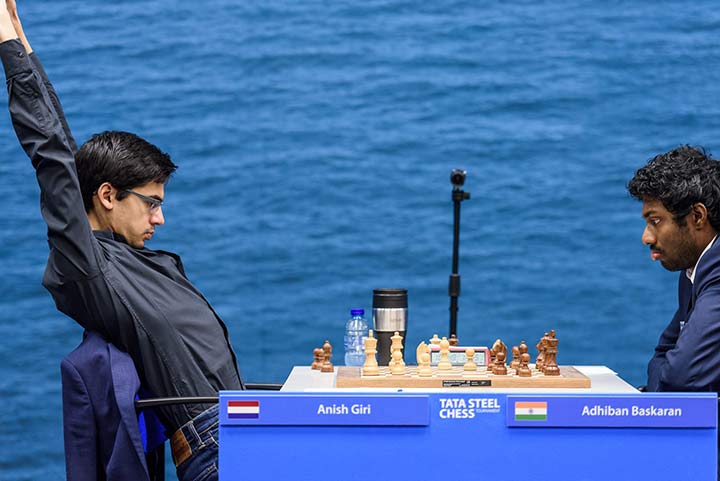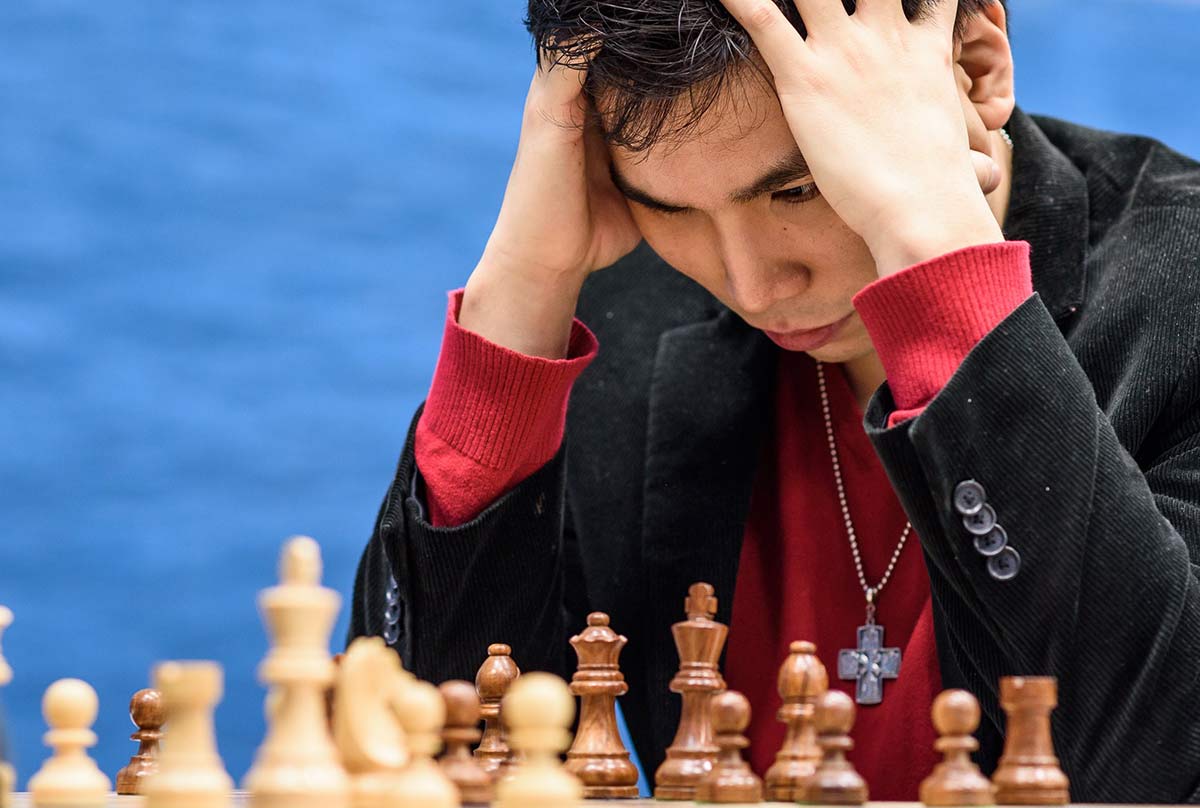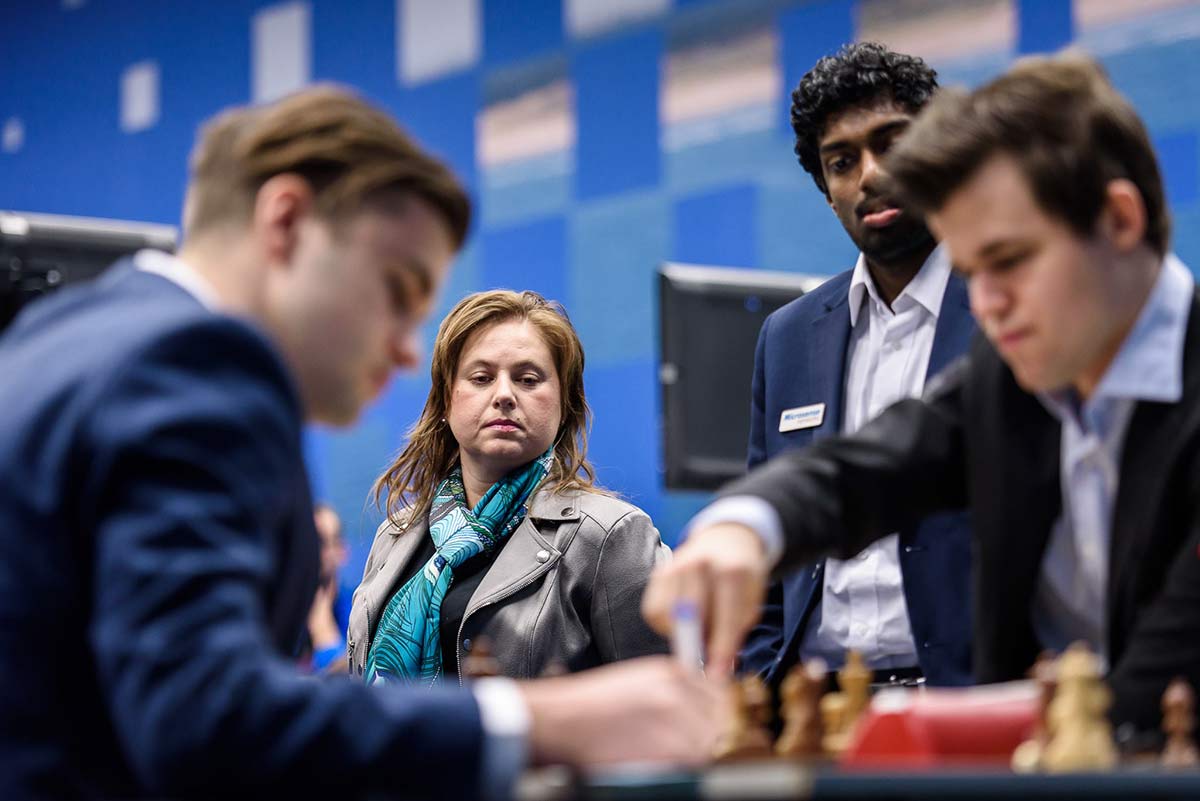


Anish Giri is having his best performance in Tata Steel Chess ever, and faces one final test on Sunday in round thirteen. He joked in his post-game interview after round eleven that talk of a tiebreak was premature, "like marrying and skipping your wedding night", but now it looks like a real possibility. Both players will have black. Mamedyarov gets white, but facing an in-form Anand is not exactly easy.
Round twelve in Wijk aan Zee | Tata Steel Chess on YouTube
The round kicked off with a wimper as co-leader Shakhriyar Mamedyarov played a 12 move draw with Gawain Jones. The pair began repeating moves before the game left opening theory. Mamedyarov argued that avoiding a repetition would leave him worse, and blamed Jones for not trying harder with white. Jones had been surprised by Mamedyarov's opening choice and considered a draw versus the current world number two a fine result, so he saw no reason to play on. Here's the explanation from both players immediately after the game.
Mamedyarov explains his choice to repeat | Tata Steel Chess on YouTube
Jones was satisfied to get a draw by any means | Tata Steel Chess on YouTube
Although not an "agreed" draw — which would be simply limited by recourse to some flavor of Sofia-Corsica rules — this kind of result is disappointing to spectators, and tournament rules generally should have incentives aimed at eliminating the practice of a quick repetion of moves. That could include, for instance, a "fighting prize", as implemented in Australia's Doeberl Cup, for which a player is only eligable in the absence of short draws, or a provision to replay a drawn game with a rapid time control, as tried successfully by the Zurich Chess Challenge.
Traditionally the tournament in Wijk aan Zee has never resorted to such measures, in part because with seven games per round, having some of them end unspectacularly is not a public relations disaster, if there are other interesting games to follow. Still, to see such a game from a co-leader in the penultimate round is remarkable. Most of the players asked about the incident after the round placed the blame on Mamedyarov, arguing that he should have tried to continue the game, relying on his big rating advantave over Jones of over 160 Elo points.
From the standpoint of tournament strategy, Mamedyarov has few chances to win. Even if he beats Anand in the last round, it's likely that Carlsen and Giri will at least draw, and a three-way tie would leave Mamedyarov out of the tiebreak, since he lost to Giri in round eight. The first criteria is "direct encounter". The same applies to Kramnik — even if he manages to beat Adhiban with black in round thirteen, and by some miracle Carlsen and Giri both lose, Kramnik's loss to Giri would prevent him from contending a tiebreak.
Anand-So was an interesting theoretical dispute in an opening the White player knows a thing or two about. There were probably one or two chances to retain a slight edge, and the jury is still out on the interesting 21.b4!? which would definitely have provoked flashbacks in the Black player. That being said, once Black had equalised there was nothing really left of the game.

Wesley So has had fine results, but never challenged for the top spots | Photo: Alina l'Ami © 2018 Tata Steel
Hou-Wei was also a psychologically interesting game in that the World Champion adapted an idea used against her in the very first round and nearly executed it even better. She definitely had a large advantage in a queen and single rook 'endgame', though the advantage dissipated when she accidentally opened a few routes for Black's eventual counterplay.

Judit Polgar arrived on Saturday as a special guest of the tournament | Photo: Alina l'Ami © 2018 Tata Steel
Carlsen-Matlakov was a 'typical Carlsen game' in that, without seeming to have any special preparation, the World Champion obtained an endgame position where his opponent had to play precisely to either keep a pawn or obtain compensation for it, and ended up doing neither. While the resulting position could maybe still have been held, in practice that was simply never going to happen.
— Willum Morsch (@WillumTM) January 27, 2018
Kramnik-Caruana was another 'concept game', just like the one Kramnik himself lost in the previous round to Karjakin- straight out of the opening White goes for the bishop pair, gains an edge, cashes in for a pawn and then converts. An idle curiosity- given the reputations of the two players, when was the last time Kramnik and Carlsen both played 1.e4 in the same round of an event?
In Giri-Adhiban, Black's opening experimentation came unstuck, slowly at first but then increasingly rapidly. Having tried to do this kind of thing many times myself I can empathise completely, and while there are some concrete suggestions for where Black could plug holes if future players really do want to do this, the fact of today's game was that White simply played better. The finish was especially convincing.
Commentary by GM Eric Hansen and GM Jan Smeets | Tata Steel Chess YouTube
Vidit broke the tie with Korobov by winnng with black and is now the heavy favourite to qualify to the masters.
See: Tata Steel Challengers: Vidit has the edge
Standings after twelve rounds